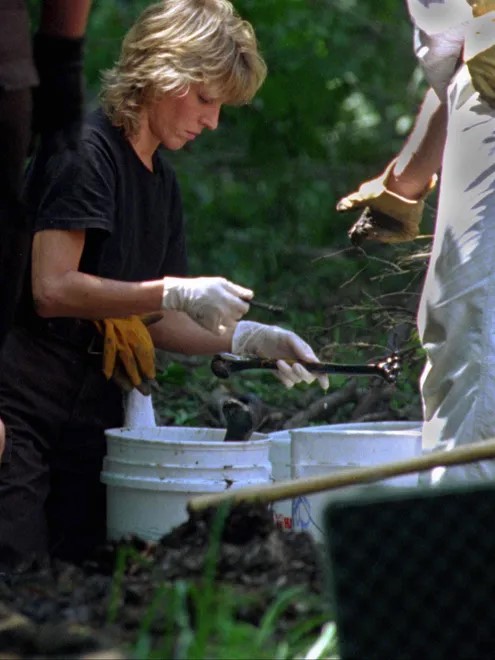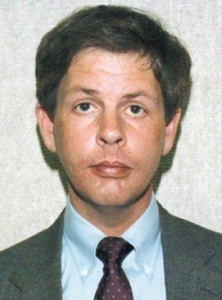(Apr. 7, 1947 – July 3, 1996). Indiana’s most notorious serial killer, Herbert R. Baumeister, was born in Indianapolis’ neighborhood to Elizabeth (Schmidt) and Dr. Herbert E. Baumeister. He was the oldest of four siblings. The family moved to with the success of Dr. Baumeister’s career.
Baumeister attended North Central High School, where he exhibited signs of antisocial behavior. His peers noted Baumeister’s curiosity about the taste of human urine and his interest in dead animals. Teachers contacted Baumeister’s parents for help after he placed a dead crow on a teacher’s desk and later urinated on the same teacher’s desk. Furthermore, he routinely disrupted class time with emotional outbursts.
Baumeister’s father took him to a psychiatrist, who diagnosed him with paranoid schizophrenia and antisocial personality disorder. It remains unclear whether Baumeister received treatment for his disorders.
After returning to North Central High School, he exhibited socially acceptable behavior for a few years. However, remembered for his former unconventional behavior, his peers at the high school shunned him, which led to his reclusiveness. He graduated in 1965 and attended Indiana University (IU) for one semester. His father urged him to return in 1967, but Baumeister again left the university after one semester, taking a job at the as a copyboy. His unpredictable behavior and emotional outbursts continued in the workplace.
While at IU, he met Juliana Saiter, a high school journalism teacher and part-time student at IU. The couple married in November 1971 and settled in the Steinmeier neighborhood in northeast Indianapolis, where they had three children. Shortly after his wedding, for two months in May 1972, Baumeister’s father committed him to a psychiatric hospital due to severe depression. One month after his release, he enrolled at but repeated his earlier pattern of dropping out after one semester.
Neighbors in Steinmeier remembered him as a bit eccentric, overly accommodating, and hot-tempered. He collected coverless magazines that grocery stores had discarded to distribute to neighbors. He would camp out in front of box offices to purchase concert tickets for himself and his younger neighbors. And he unleashed his fury upon neighborhood contractors and members of the homeowner’s association when told he could not decorate a newly constructed neighborhood entrance sign with gaudy flowerpots.
In 1974, Baumeister found work at the Indiana Bureau of Motor Vehicles (BMV). Here he openly showed his untraditional ideas about gender roles when he sent his colleagues a Christmas card of himself and another man dressed in drag. This quirky behavior shifted to him becoming domineering and aggressive. Though he rose to the level of program director, the BMV terminated him in 1985 after he urinated on a letter to Governor Robert D. Orr and was held responsible for urine found months earlier on his manager’s desk.
Out of work, Baumeister spent time drinking and in Indianapolis gay bars. He was arrested for a hit-and-run accident while drunk in September 1985 and for conspiracy to commit theft in March 1986. Both charges were dropped. He finally found a job at a thrift shop, where he discovered an interest in retail work.
Baumeister borrowed $4,000 from his mother and opened his thrift store, Sav-A-Lot, in 1988. The organization, cleanliness, and full stock of quality used goods distinguished Sav-A-Lot from other thrift shops. In 1991, with the success of his business, Baumeister moved his family to an 18-acre ranch in which he called Fox Hollow Farms. He also gained the confidence to open a second Sav-A-Lot.

However, the second store was not as successful as the first one. By the summer of 1993, employees of Baumeister noticed his increasing volatility and long periods of absence during the workday. Financial strain and lawsuits against the company for nonpayment of services hampered business.
As Sav-A-Lot spiraled out of control, a series of macabre events occurred. Between 1992 and 1994, numerous gay men had been reported missing in the Midwest. In November 1994, Baumeister’s 13-year-old son found a human skull on the Fox Hollow Farms property. Baumeister claimed the skull belonged to a collection of skeletons his father Dr. Herbert E. Baumeister maintained.
Not long after this discovery, investigators with the and the received a tip about a missing person case from 1992. The witness reported seeing a man named Brian Smart leave an Indianapolis gay bar with Roger Goodlet, who had disappeared after that incident in 1992. Unable to locate Brian Smart, the case lay cold. Later, in 1995, the witness again saw Brian Smart at a gay bar. He followed Smart and wrote down the license plate number of his car. Police identified the car as registered to Herb Baumeister.
On January 4, 1996, several months after police questioned her about a possible link between her husband and the disappearances of several men, Juliana Baumeister filed for divorce. In early June, she informed investigators of the skull her son had found on the property and consented to a search of the Fox Hollow Farms property while Baumeister was out of town on June 24, 1996.
Police and forensic investigators found over 10,000 charred and decomposed bones and bone fragments along with handcuff remnants and shotgun shells. The University of Indianapolis forensic labs tested and cataloged all the evidence. By September 12, the forensic team confidently identified the remains of four individuals: Richard Hamilton, Manuel Resendez, Steven Hale, and Roger Goodlet. Each victim was a gay man whose disappearances coincided with periods in 1993 and 1994 when Baumeister’s wife and children were out of town.
On June 30, 1996, after learning the police had issued a warrant for his arrest, Baumeister fled to Ontario, Canada. He committed suicide in Pinery Provincial Park in Grand Bend, Ontario, on July 3. In a three-page suicide note, he mentioned remorse over the breakup of his marriage and the financial issues with his business. He made no mention of either the remains found on his property or his role in the missing person cases.
Over the next two years, investigators pieced together the extent of Baumeister’s crimes. Forensic investigators found 11 DNA profiles among the remains that helped to identify four more victims: Johnny Bayer, Jeff Allen Jones, Allen Wayne Broussard, and Michael Kiern. Investigators determined Baumeister generally targeted white men between the ages of 14 and 46 with ties to the LGBTQ community. He would choose his victim at an Indianapolis gay bar, bring him to Fox Hollow Farms, where he strangled him and disposed of the body.

Baumeister’s victim count increased in 1998 when investigators linked him to the “I-70 Strangler” murders from the 1980s. Between 1980 and 1991, the bodies of 11 gay men were found, many partially nude, in streams across rural areas of central and western Ohio that Interstate 70 crossed. The cause of death was strangulation. Because the victim profiles and cause of death aligned with Baumeister’s case, investigators intensified their search for a connection between him and the “I-70 Strangler.”
Baumeister had been seen in western Ohio around the same time the “I-70 Strangler” murders occurred and was also known to spend time at the in , where one of the victims, Michael Riley, was last seen before he disappeared in 1983. A witness had come forward to share a description of the man with whom Riley had left, but investigators could not identify the suspect. However, with the photograph of Baumeister in hand, the witness positively named him as the possible perpetrator. Investigators from each of the counties where victims were found concluded that Baumeister was the “I-70 Strangler.”
In the early 2020s, the Hamilton County Coroner’s office, the Indianapolis Metropolitan Police Department’s Missing Persons Unit, the Indiana State Police, and the University of Indianapolis renewed their investigation of Baumeister’s case. On December 4, 2022, a team of 11 cadaver dogs searched the Baumeister property and discovered one bone and several locations for further investigation. In 2023, the FBI analyzed thousands of bone fragments believed to be from at least 25 individuals to identify other victims.

Help improve this entry
Contribute information, offer corrections, suggest images.
You can also recommend new entries related to this topic.





